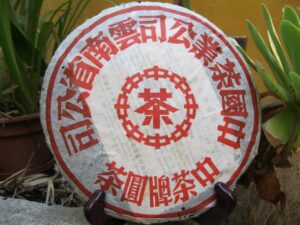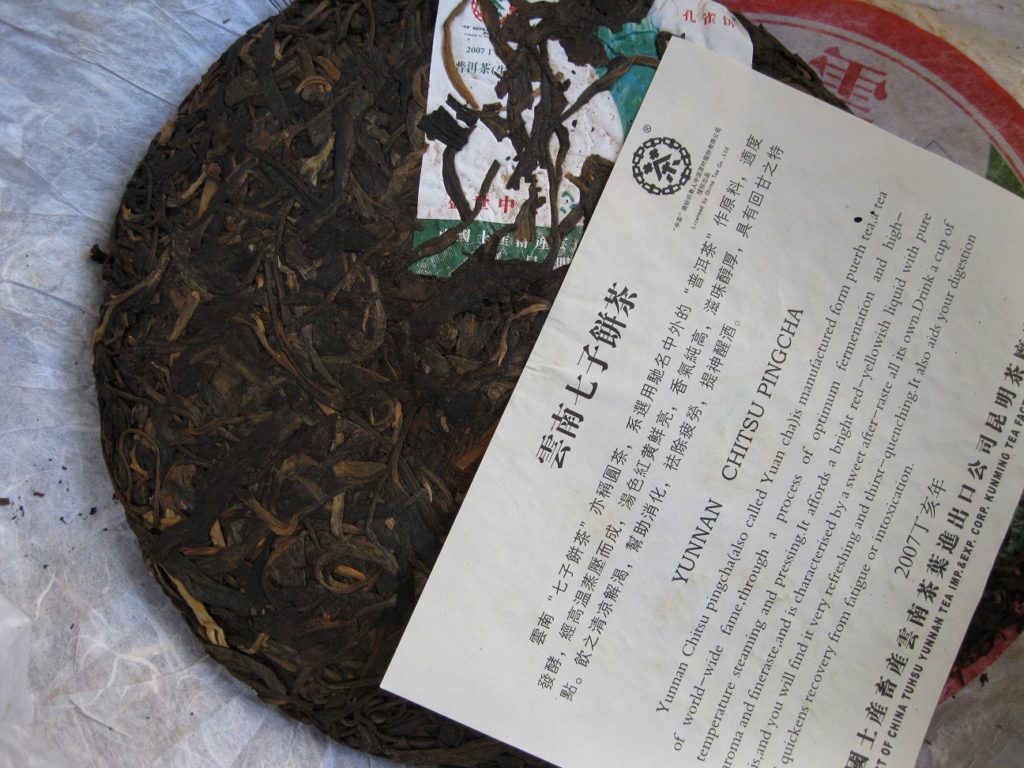Turning Up Heicha
Turning Up Heicha came about from a reflection upon a number of dry-stored productions from about ’98-’07 that possess a quintessentially heicha character. “Heicha” is a class of tea to which puerh belongs but is processed in different provinces. “Puerh” is a trademarked name similar to champange, so technically other places technically cannot use the term. Other types of heicha are fucha and liubao. Typically, heicha’s association with puerh is with ripes given the processing technique, but older raws venture into the heicha category as well. Puerh Junky will be visiting raw with heicha expression in this post.
HK Returns Cake, Zhongcha
Among the varying HK Returns offerings from ’07, the HK Returns Cake proved the burliest. The lack of sweetness acquired in ’16 constituted a continuing conundrum. I porcelained a portion about two years ago in ’21 Spring. The porcelained version is not recognizable from previously associations, though the listing blurb duly notes that it strode a road toward berry fruit-osity. Another portion of the same cake, stored differently, still possesses the tobacco tinge.
Only one tasting of the ’21 acquisitions (about three) transpired, and it expressed camphor sweetness indicative of greater humidity. Overall, the HKR Cake has great durability and depth, with some of the stronger character from its youth coming though.
HK Returns Iron Cake, Zhongcha
Since we’re talking about heicha and Zhongcha and HK Returns, there’s the Iron Cake. The pauperly Puerh Junky only has one of these for sale. It’s absolute magic. To be perfectly honest, were I looking for this taste, I’d probably venture into Dancong’s. It’s extremely well constituted: sweet, thick, and with lemony notes on the top. Lemonene expresses in Hideout, LME, but Hideout has an identifiably puerh character and complexity. The HK Iron could be easily classified as a well preserved dancong or better yet, a well-stored fucha of about 8 yrs old.
Macau Raw Brick
The 2000 Macau Raw Brick isn’t for sale, but it serves as a solid touchstone for appreciating the transformation of raw puerh. It has a depth that perhaps surpases heicha at it current stage. Mind you, Puerh Junky doesn’t do much heicha drinking. The variables of Mainland storage, travel, and storage on the LA side albeit separate intersect. By the time the MRB reached performance level, it was difficult to determine which variable factored most. This brick happens to be referenced in the Puerh Yearbook. It’s devoid of any humidity, so there’s no “old taste” per se, but it’s aged fully.
Du Qiongzhi 7532
The ’03 Du Qiongzhi 7532 comes in a bold Red Mark wrapper and progressed beyond the initial tobacco stage. This particular cake, acquired in ’15, has never received full treatment. . . or maybe it has to its detriment. It received the “top-shelf tx,” productions that were more enclosed and even placed in the sexy cardboard boxes aptly fitting single cakes. The thing is that the cardboard aroma bleeds into the cake while zapping it of certain essential esscenses. It’s been much work trying to bring this cake around. It’s going on two years now, and if it’s been tinned, I don’t know where such tin is stashed. In any event, it seems it wants to emerge as the porcelained version of the HK Returns Cake does but just hasn’t juiced up enough given the top-shelf tx. It’s from Meitra Du’s own collection, so the junky side of me thought to be extra careful with little basis for knowing what extra care meant given my conditions and the conditions of the cake. An Aug ’22 session produced by far the most enjoyable session and this summer seems to be a good time to really give it a push. I do have two non-cardboard affected cakes. The wrapper is thin cotton paper of distinctive quality. Though horribly tattered at the edges, I don’t recall any staining.

’03 Du 7532
Thick Zen, Zhongcha
Thick Zen epitomizes the enigma of puerh. My first encounter with it was around ’17. It looked horrible and tasted of absolutely nothing. I knew it must be good, but I didn’t know how long it would take. Its viscosity clung to me and anticipation of it morphing into root beer oozed from my being. I drank and sampled much from the first two cakes, convinced it was Yiwu.
The second batch of TZ has the same thickness, but the storage was dry, it appears, beyond the stage of turning camphor, wood, or rooty. Could be the material as well. Batch two is far sassier, with the fruit note far more up front, with stone fruit sour, a bit of raisin in the nose. It’s like a strong boiling of dried cherry and peach without the sugar added. Picking up some grape nose as it rehydrates. By June ’23 it should be in good form, it’s already much sweeter than at the beginning of the month and there’s even some vanilla and complexity that garned its praises previously.
What’s not Heicha
Neither Poison nor some Yiwus are coming off as heicha. I’d say the Yiwu Gratitude is venturing toward heicha, but the Prince is holding true to a darker note. A number of the 6FTM Yiwu on hand have turned petrol in the same time frame. All of these hail from backgrounds of decidedly more humid conditions. When and how much humidity gets applies plays a major role in how the production will manifest. Raw puerhs possess a degree of dynamism that cannot be found with other heicha, but through prolonged dry storage with heat they manifest as a bona fide heicha character. Counterintuitively, ripes take considerably longer to have heicha traits to emerge. The exception to this is the big leaf sancha, which might be processed in a fashion quite similar to liubao.
Wrapping Up
This desultory passage on raws Turning Up Heicha is just one of the ongoing reflections upon storage. Although ripe puerh technically fits within the category of heicha, it doesn’t possess the fruit character until considerably aged and often never (there are obvious exceptions). Conversely, raw puerh can turn up heicha quite often given the right measure of heat and dryness. Raw productions like the HK Returns Cake and the Du 7532 that previously fell under the tobacco class have been marching ever resolutely toward heicha brightness. Both cases demonstrate how slight variations in storage variables can produce notable differences. The HK Returns Iron was first sampled last year, ’22. There was no need to taste before then, because it was clear that offerings of this nature needed a solid 15yrs storage before sampling. It’s certainly the most outstanding among the HK Returns Series. Age being what it is, there are nevertheless great storage matters requiring tending. The Thick Zen second batch is every bit as thick, but needs some loving before performing optimally. Complex notes are starting to form and it’s possible that storage intensity may reawaken its puerh essence, but for now it’s trending decidedly in the direction of heicha. Finally, some reference points contrasting from heicha provide the reader with the Puerh Junky’s thinking on the matter.

